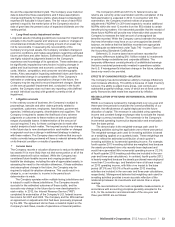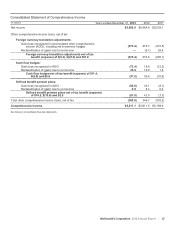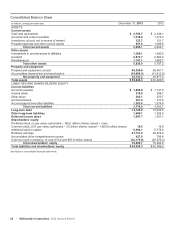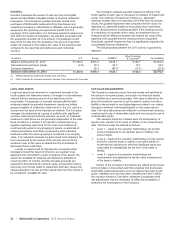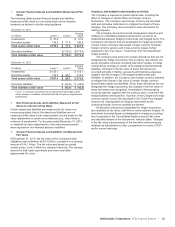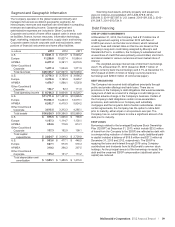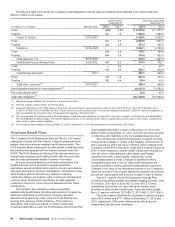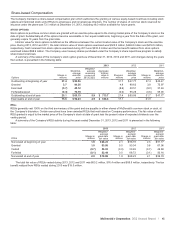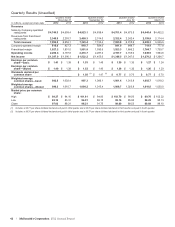McDonalds 2013 Annual Report Download - page 40
Download and view the complete annual report
Please find page 40 of the 2013 McDonalds annual report below. You can navigate through the pages in the report by either clicking on the pages listed below, or by using the keyword search tool below to find specific information within the annual report.
32 | McDonald’s Corporation 2013 Annual Report
GOODWILL
Goodwill represents the excess of cost over the net tangible
assets and identifiable intangible assets of acquired restaurant
businesses. The Company's goodwill primarily results from
purchases of McDonald's restaurants from franchisees and
ownership increases in subsidiaries or affiliates, and it is generally
assigned to the reporting unit expected to benefit from the
synergies of the combination. If a Company-operated restaurant is
sold within 24 months of acquisition, the goodwill associated with
the acquisition is written off in its entirety. If a restaurant is sold
beyond 24 months from the acquisition, the amount of goodwill
written off is based on the relative fair value of the business sold
compared to the reporting unit (defined as each individual
country).
The Company conducts goodwill impairment testing in the
fourth quarter of each year or whenever an indicator of impairment
exists. If an indicator of impairment exists (e.g., estimated
earnings multiple value of a reporting unit is less than its carrying
value), the goodwill impairment test compares the fair value of a
reporting unit, generally based on discounted future cash flows,
with its carrying amount including goodwill. If the carrying amount
of a reporting unit exceeds its fair value, an impairment loss is
measured as the difference between the implied fair value of the
reporting unit's goodwill and the carrying amount of goodwill.
Historically, goodwill impairment has not significantly impacted the
consolidated financial statements.
The following table presents the 2013 activity in goodwill by
segment:
In millions U.S. Europe APMEA(1) Other Countries
& Corporate(2) Consolidated
Balance at December 31, 2012 $1,294.2 $ 881.4 $ 438.7 $ 189.7 $2,804.0
Net restaurant purchases (sales) (0.6) 50.4 30.7 15.7 96.2
Currency translation 26.3 (40.7) (13.1) (27.5)
Balance at December 31, 2013 $1,293.6 $ 958.1 $ 428.7 $ 192.3 $2,872.7
(1) APMEA represents Asia/Pacific, Middle East and Africa.
(2) Other Countries & Corporate represents Canada, Latin America and Corporate.
LONG-LIVED ASSETS
Long-lived assets are reviewed for impairment annually in the
fourth quarter and whenever events or changes in circumstances
indicate that the carrying amount of an asset may not be
recoverable. For purposes of annually reviewing McDonald’s
restaurant assets for potential impairment, assets are initially
grouped together at a television market level in the U.S. and at a
country level for each of the international markets. The Company
manages its restaurants as a group or portfolio with significant
common costs and promotional activities; as such, an individual
restaurant’s cash flows are not generally independent of the cash
flows of others in a market. If an indicator of impairment (e.g.,
negative operating cash flows for the most recent trailing 24-
month period) exists for any grouping of assets, an estimate of
undiscounted future cash flows produced by each individual
restaurant within the asset grouping is compared to its carrying
value. If an individual restaurant is determined to be impaired, the
loss is measured by the excess of the carrying amount of the
restaurant over its fair value as determined by an estimate of
discounted future cash flows.
Losses on assets held for disposal are recognized when
management and the Board of Directors, as required, have
approved and committed to a plan to dispose of the assets, the
assets are available for disposal, the disposal is probable of
occurring within 12 months, and the net sales proceeds are
expected to be less than its net book value, among other factors.
Generally, such losses relate to restaurants that have closed and
ceased operations as well as other assets that meet the criteria to
be considered “available for sale”.
FAIR VALUE MEASUREMENTS
The Company measures certain financial assets and liabilities at
fair value on a recurring basis, and certain non-financial assets
and liabilities on a nonrecurring basis. Fair value is defined as the
price that would be received to sell an asset or paid to transfer a
liability in the principal or most advantageous market in an orderly
transaction between market participants on the measurement
date. Fair value disclosures are reflected in a three-level hierarchy,
maximizing the use of observable inputs and minimizing the use of
unobservable inputs.
The valuation hierarchy is based upon the transparency of
inputs to the valuation of an asset or liability on the measurement
date. The three levels are defined as follows:
Level 1 – inputs to the valuation methodology are quoted
prices (unadjusted) for an identical asset or liability in an
active market.
Level 2 – inputs to the valuation methodology include quoted
prices for a similar asset or liability in an active market or
model-derived valuations in which all significant inputs are
observable for substantially the full term of the asset or
liability.
Level 3 – inputs to the valuation methodology are
unobservable and significant to the fair value measurement
of the asset or liability.
Certain of the Company’s derivatives are valued using various
pricing models or discounted cash flow analyses that incorporate
observable market parameters, such as interest rate yield curves,
option volatilities and currency rates, classified as Level 2 within
the valuation hierarchy. Derivative valuations incorporate credit
risk adjustments that are necessary to reflect the probability of
default by the counterparty or the Company.



